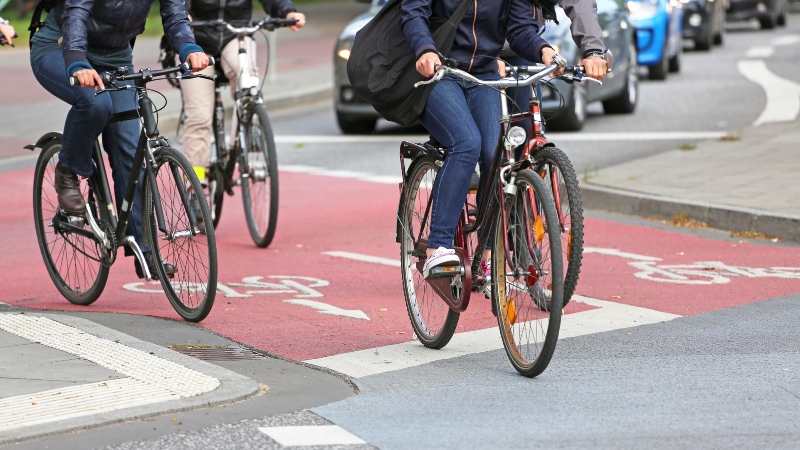
QECIO 2.0: Unleashing the Power of OpenStreetMap for Sustainable Mobility
This year, ECF has once again explored the potential of using OpenStreetMap (OSM) to quantify cycling infrastructure across Europe. Our tool, Quantifying Europe’s Cycling Infrastructure using OpenStreetMap (QECIO) 2.0, equips policymakers and advocates with detailed data on cycling infrastructure across the continent.
Data on infrastructure is required to make transportation systems more environmentally and socially sustainable. As we believe that cycling is a key element for sustainability, we wanted to gather and present data on cycling infrastructure. However, the collection and provision of data on bicycle infrastructure is sometimes lacking. This gap needs to be filled to harness the potential of data-driven bicycle network planning. Quantitative analyses of cycling networks can assist planning decisions and improve outcomes. Likewise, the quantification of data allows us to track policy decisions and developments. This is especially important now, as we eagerly await the EU Cycling Declaration. Therefore, the need for information sources is vital to making data-driven decisions.
Compiling bicycle infrastructure data directly from different countries requires an enormous time investment due to the need to assemble data from different sources and reconcile differences in naming conventions, timeliness and accuracy. This is where we see the opportunity to use open data sources to quantify infrastructure across borders and get a picture of reality on the ground.
What are open data and OSM?
The role of open data – data that can be freely used, re-used, and redistributed by anyone - has grown exponentially in the development of projects for mobility. These systems are gaining attention and recognition globally because they allow users and communities to generate data in a decentralised way. User contributions can cover topics ranging from cycling infrastructure to traffic incidents. The use of open data resources is growing, enabling transparency and collaboration and providing access to valuable information.
Among the open data initiatives, OpenStreetMap (OSM) is considered among the most successful, providing data for different applications. OSM is a database of geographic data which follows three pillars. First, the database is free for anyone who wants to use it and it can be edited with any software. Second, OSM is open. This means that with few resources, anyone can participate in OSM in different ways. Do you want to add a road? Do you want to share a new facility installed in your neighbourhood? In theory, anyone with internet connection is free to add this information. Lastly, the project is collaborative. OSM is produced through collective work by people in different contexts contributing data.
It is no surprise that OSM has become a favourite for researchers and analysts. Last year, we at ECF already explored the various ways in which OSM can be a resource for cycling advocates in the article “Exploring OSM’s potential as a cycling infrastructure database”.

Our experience
We wondered if it was possible to apply similar thinking and quantify cycling infrastructure on a larger, European scale.
The short answer is yes, it is! The long answer is also yes, but we can always keep improving.
Our first approach was to explore the results from different cities at the European level. We presented these in the first version of Quantifying Europe’s Cycling Infrastructure using OpenStreetMap (QECIO 1.0).
This year, we expanded the project into its current version. As of July 2023, QECIO 2.0 analyses 525,000km of cycling infrastructure (including 339,000km of segregated infrastructure) in 37 countries across 1,166 regions (NUTS 3). Compared to the previous edition, it includes more types of cycling infrastructure, examines additional OSM tags and displays the information in five detailed interactive maps. Whereas the map from the first edition only displays the ratio of cycling infrastructure to the main road network, QECIO 2.0 also covers information on specific types of cycling infrastructure, contraflow cycling and the availability of additional data.
A large part of the process was translating information available in OSM, coded in the database under multiple names and tags, into useful results for the cycling community. Collecting and interpreting the data is a significant step which allows us to standardise what is being reported in the European OSM base map.
Using OSM has allowed us to compile data for different countries, standardise data beyond political boundaries and generate some analysis that we hope will be valuable for cycling advocates. It is a step forward in the monitoring of what cycling infrastructure exists on the ground, working as a first line sensor. You can visit our data here.
Our experience demonstrates the usefulness of OSM in gathering data on cycling. The QECIO 2.0 tool allows for the collection of data which could otherwise be costly or difficult for national mapping agencies to do frequently. Furthermore, the indicators we have developed in the tool give a first line of analysis of what is happening at the European scale. However, OSM data is also utilised for cycling research and planning in a broad variety of settings. Previous research has found that the accuracy of OSM data can be higher than from official government or municipal sources (Ferster et al., 2020; Viero et al., 2023). For example, the City of Warsaw provides cycling infrastructure data to OSM and Transport for London’s Cycling Infrastructure Database (visualised by CycleStreets) is being migrated to OSM. Such data is also used by consulting companies and NGOs due to its low cost and easy accessibility. OSM data can be used to understand how certain infrastructures are evolving over time (Bres et al., 2023) or to generate predictions for better cycle network growth (Szell et al., 2022). Therefore, OSM holds a lot of potential waiting to be explored and we encourage people to keep using it.
On the other hand, using open data sources such as OSM also brings discussions and concerns that should be addressed. The quality of the data is one of the main concerns. For instance, OSM labelling practices take place across many cities and countries. We try to take the differences into account and perform some cross-checking in every step. In addition, we eagerly welcome feedback from anyone who spots some errors or inconsistencies in the data we present. Local knowledge is key to improving the OSM base map, and consequently our project. Another issue is that the completeness of OSM data has been shown to be uneven, with a bias towards urban areas which have more detailed descriptions (Ferster, 2020). It is expected that more errors and inconsistencies can be found in certain areas, but this can only be concluded through a deep exploration of the data. However, we see our approach as an ambitious start to exploring the usefulness of OSM data on cycling infrastructure across the 37 countries analysed.
If you are particularly interested in the use of open data for cyclist, we invite you to look at the article from Nelson et al. (2020) “Crowdsourced data for bicycling research and practice” to be aware of the current state of crowdsourced data for cycling research and practice. The author summarises the challenges intrinsically associated with the use of open data for cycling research and practice with some recommendations for supporting research on and for cycling policy development. The author remarks that only through combined efforts can projects based on open data engage people to contribute information, stories, and experiences, which can later be translated into evidence for decision making and cycling advocacy.

What next?
The importance of open data continues to grow around the world and OSM is already a key example of the usefulness of collaborative and local knowledge. OSM contributions increase every year, conventions take place where mappers discuss improvements and governments are even starting to use OSM data seriously, with many local municipalities working with the OSM community. Given the growth and increasing acceptance of OSM, the completeness of its data is likely to increase in coming years.
Using OSM, we have generated data that can be of use to cycling advocates and we have shown that open data is a useful tool for generating accessible knowledge that can be used for data-driven policy making.
Open data offers the opportunity to explore what is happening with infrastructure in different areas and what users find important. Such datasets bring a series of opportunities to analyse our surroundings, to monitor changes and to identify where funding needs to be allocated. However, open data usage will always bring challenges and discussions. It is a powerful tool in our pockets that needs to be used critically to shape the infrastructure of our future. We welcome anyone who uses our tool to explore OSM, make contributions and to contact us with any feedback or comments you may have!
Contact the author
Recent news!
Contact Us
Avenue des Arts, 7-8
Postal address: Rue de la Charité, 22
1210 Brussels, Belgium









